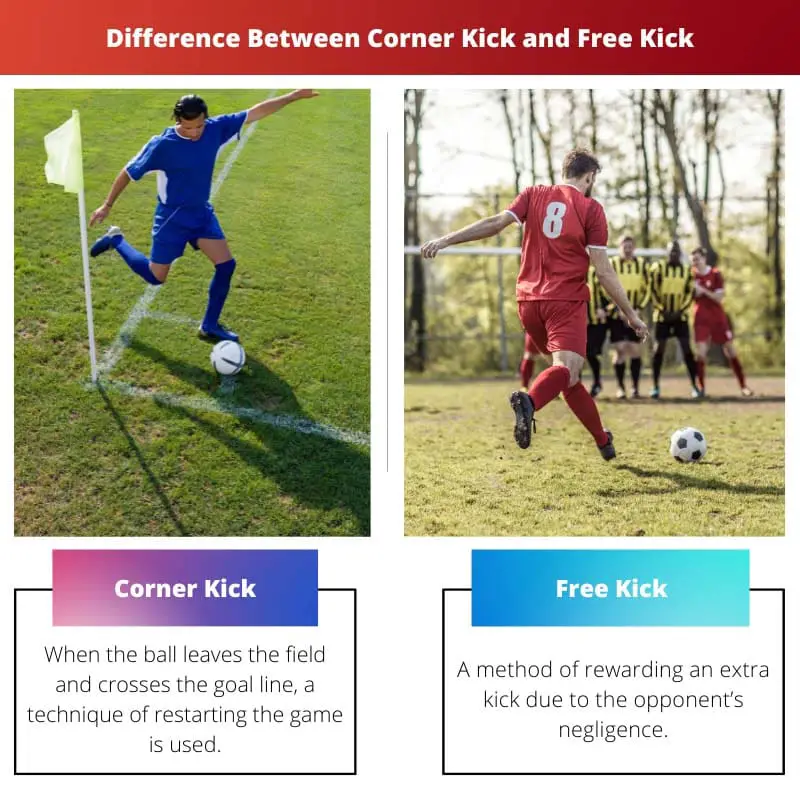Football has over fifty-one types of kicks, and two of such kinds are corner kicks and free kicks. Corners are a great spot to score goals easily, although, with apropos instructions, one can play the corner kick.
Free Kicks are reward kicks given to a team when the opposing team violates the basic football protocols.
Key Takeaways
- Corner kicks are awarded in soccer when the defending team last touches the ball before it crosses the goal line without a goal being scored, while free kicks are awarded for various fouls committed by the opposing team.
- Corner kicks are taken from the corner of the field closest to where the ball went out of play, while free kicks are taken from where the foul occurred.
- Corner kicks result in scoring opportunities due to their proximity to the goal. In contrast, free kicks can be taken from various distances and may only sometimes lead to direct scoring chances.
Corner Kick vs Free Kick
A corner kick is awarded when the defending team last touches the ball before it crosses their goal line without a goal being scored. The attacking team takes the kick from the corner nearest to where the ball went out. A free kick, however, is granted following a foul or a technical infringement, and the team not committing the violation takes the kick from the spot of the offence, potentially creating goal-scoring opportunities.

A Corner Kick is a direct kick that is used to restart a game when the final defender touches the ball as it crosses the goal line.
When the ball is in the corner, a corner kick is taken in the corner arc near the goal line, and the opponents are 9 meters away from the corner arc.
A free kick is a reward offered by the referee when there is a foul or violation of the laws by the opposing team.
There are both direct and indirect free kicks, with direct free kicks being the more common(goal scorable) for serious offences, while indirect (fewer chances of scoring a goal) are for superficial ones.
Comparison Table
| Parameters of Comparison | Corner Kick | Free Kick |
|---|---|---|
| Definition | When the ball leaves the field and crosses the goal line, a technique of restarting the game is used. | A method of rewarding an extra kick due to the opponent’s negligence. |
| Types | Short corner, top-of-the-area, near post, medium, direct score, and the far post. | Direct and Indirect free kicks. |
| Rules | The ball must be over the end of the field and lastly touched by the defender. | Play begins as soon as the ball kicks in. |
| Applied for | When the ball passes over the corner; the defender touches the ball, the game will restart. | When opponents violate the rules of football, a free kick is awarded to the other team. |
| Also known as | Goal Kick | Penalty Kick |
What is Corner Kick?
Corner Kick is a lucky break in football for players against their opposing team. When the ball goes out of the playline in football, reaches over the goal post and has been touched lastly by the defending team, then the whole game will restart.
And this type of method of restarting the game following this rule rewarded by the referee is called a corner kick.
Accordingly, this method is a big plus, as it allows the team to score a goal. Moreover, this method rewards an opportunity for the team against the opposing team. Corner Kick was introduced as a part of Sheffield Rules in 1868.
Furthermore, there are two key requirements for playing a corner kick: first, the ball must be placed in the middle of the corner arc closest to where it crossed the goal line, and second, opponents must remain nine meters away from the corner arc until play begins.
Similarly, the ball has to remain stationary when it is kicked and is taken by a defender. Secondly, it is in play whenever the ball is kicked and moves.
It doesn’t need to leave the corner area. Thirdly, the corner flag should not be moved. Until the ball hits the ground, the opponents must stay at least nine meters away from the corner arc.

What is Free Kick?
In the same way, a free kick is also a reward offered by the referee when there is a violation of the rules by the opposing team. To put it in simple words, when the opposition side breaks the rules, the referee awards a free kick to the other team.
Free kicks can either be in direct or indirect goals.
Direct free kicks (goal scorable) are for serious offences, while indirect are for superficial ones.
There were no defined penalties for breaking the rules in the original laws of the game till 1863. Consequently, FIFA set the free kick in 1872 as a punishment for illegal handling of the ball but later extended it to other offences.
To play a free kick, all the players from the opposing team must keep 9 m away from the ball. In addition to it, the penalty kick is a direct free kick awarded to the attacking team, placed 11 meters from the goal, with the goalkeeper and kicker outside of the penalty area.
For instance, jumping at another player, holding the ball in hand, and a few other actions that affect opponents will result in free kicks to the opposing team.

Main Differences Between Corner Kick and Free Kick
- The game can be restarted with a corner kick, whereas with a free kick, the opposing team is awarded one.
- The moment the ball crosses the goal line without being scored on when opponents last touch the ball, Corner Kick is given. A free kick, on the other hand, is awarded when a player breaks the rules.
- Corner Kick was established in 1868, whereas Free Kick was in 1872.
- A corner Kick works only when the ball is inside the corner radius, whereas a free kick can be direct or indirect.
- A corner Kick is in the hands of the playing team; on the other hand, free kicks are like rewards, which are due to the transgression of the opposing team.

- https://www.tandfonline.com/doi/abs/10.1080/24748668.2021.1932146
- https://www.tandfonline.com/doi/abs/10.1080/15459624.2015.1072632
